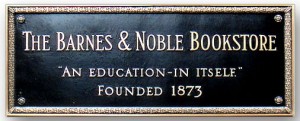June 29th, 2015
Barnes & Noble released its fiscal year 2015 earnings report last Thursday.
Revenues of $6.1 billion decreased 4.9% from 2014 although net earnings squiggled in at $36.6 million (.6% of sales), up from a loss of $47.3 million the previous year. This profit didn’t reflect an improvement in the profits from store sales but rather a decrease in losses from the failed Nook division (which doesn’t have much left to lose).
My interest in Barnes & Noble’s financials is not centered on the company. Barnes & Noble’s changing sales data is the key indicator of what is happening in retail trade book sales in the United States. What happens at Barnes & Noble doesn’t stay at Barnes & Noble.
There are several means available to weigh the decline in book sales at the chain.
The broadest indicator is the overall retail sales of the company (separate from its College and online divisions). Barnes & Noble retail peaked in 2010 with sales of $4,947,469. Sales this year clocked in at $4,108,200, a 17% decrease over five years.
The number of retail stores dropped 10% in the period, and total square footage dropped 8.5% (although square footage devoted to books certainly decreased by a larger (unspecified) number).
The company is cagey about breaking out sales by product category. Non-book sales were pegged at 23% in 2013 and CEO Michael Huseby said in a call last week that “toys and games in particular grew 16% on top of the 12% increase of a year ago.” That lifts the non-book category to 33% of sales. By this calculation book sales decreased by 12% in just the last two years.
At the same time the number of titles the chain carries has declined. In its latest report the company states that “each Barnes & Noble store features an authoritative selection of books, ranging from 22,000 to 164,000 titles.” The number ranged from “60,000 to 200,000 titles” in 2004. The long tail at Barnes & Noble is now 18% shorter.
The other item of note is Barnes & Noble’s decline as a reseller of ebooks. Clearly “digital content” sales (the company’s term) correlate tightly with Nook sales and declining Nook sales have taken their toll. In the 2012 annual report there’s a definition for “digital content”: “The digital business includes digital content such as eBooks, digital newsstand (and) apps…” Certainly newsstand and app sales are a small portion of that total, leaving ebook sales, declining from a peak of just over $300 million in 2013 to some $175 million in the past fiscal year.
If trade ebooks were indeed a $1.4 billion market in 2014, Barnes & Noble could claim just 12.6% of that total.
Independent bookstores are increasing in number while Barnes & Noble is shutting stores. But no indicator tracks the declining fortune of retail print book sales like the annual data from Barnes & Noble.
